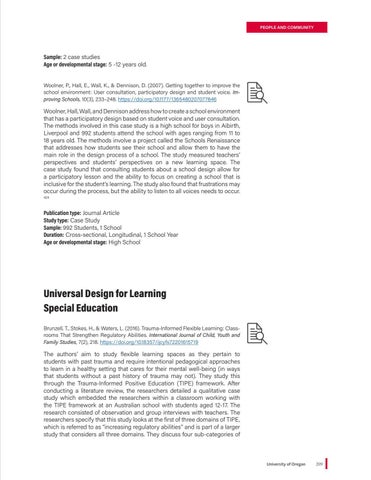PEOPLE AND COMMUNITY
Sample: 2 case studies Age or developmental stage: 5 -12 years old. Woolner, P., Hall, E., Wall, K., & Dennison, D. (2007). Getting together to improve the school environment: User consultation, participatory design and student voice. Improving Schools, 10(3), 233–248. https://doi.org/10.1177/1365480207077846
Woolner, Hall, Wall, and Dennison address how to create a school environment that has a participatory design based on student voice and user consultation. The methods involved in this case study is a high school for boys in Aibirth, Liverpool and 992 students attend the school with ages ranging from 11 to 18 years old. The methods involve a project called the Schools Renaissance that addresses how students see their school and allow them to have the main role in the design process of a school. The study measured teachers’ perspectives and students’ perspectives on a new learning space. The case study found that consulting students about a school design allow for a participatory lesson and the ability to focus on creating a school that is inclusive for the student’s learning. The study also found that frustrations may occur during the process, but the ability to listen to all voices needs to occur. 424
Publication type: Journal Article Study type: Case Study Sample: 992 Students, 1 School Duration: Cross-sectional, Longitudinal, 1 School Year Age or developmental stage: High School
Universal Design for Learning Special Education Brunzell, T., Stokes, H., & Waters, L. (2016). Trauma-Informed Flexible Learning: Classrooms That Strengthen Regulatory Abilities. International Journal of Child, Youth and Family Studies, 7(2), 218. https://doi.org/10.18357/ijcyfs72201615719
The authors’ aim to study flexible learning spaces as they pertain to students with past trauma and require intentional pedagogical approaches to learn in a healthy setting that cares for their mental well-being (in ways that students without a past history of trauma may not). They study this through the Trauma-Informed Positive Education (TIPE) framework. After conducting a literature review, the researchers detailed a qualitative case study which embedded the researchers within a classroom working with the TIPE framework at an Australian school with students aged 12-17. The research consisted of observation and group interviews with teachers. The researchers specify that this study looks at the first of three domains of TIPE, which is referred to as “increasing regulatory abilities” and is part of a larger study that considers all three domains. They discuss four sub-categories of
University of Oregon
209

